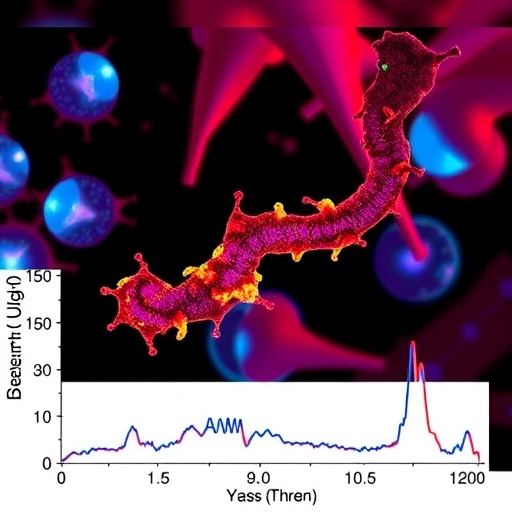Recent advances in gene therapy have opened new avenues in the treatment of Duchenne muscular dystrophy (DMD), a severe genetic disorder affecting muscle function. The research led by Walsh et al. focuses on the detailed analysis of dystrophin and mini-dystrophin expression following gene therapy, utilizing cutting-edge immunoaffinity liquid chromatography coupled with tandem mass spectrometry. This innovative approach offers unprecedented insights into the quantification and characterization of these important proteins, which are pivotal for muscle integrity.
Duchenne muscular dystrophy, caused by mutations in the dystrophin gene, leads to the absence or dysfunction of the dystrophin protein, resulting in progressive muscle degeneration. Traditional treatment methods have faced significant limitations, often focusing on symptom management rather than addressing the underlying genetic defect. Recent developments in gene therapy, however, have demonstrated promise in restoring dystrophin expression, which is essential for muscle cell stability and function.
In this groundbreaking study, the researchers employed an advanced analytical technique known as immunoaffinity liquid chromatography-tandem mass spectrometry (LC-MS/MS) to measure dystrophin levels post-gene therapy. This methodology encompasses highly specific antibody-based enrichment of dystrophin and mini-dystrophin, followed by quantification using mass spectrometry. The sensitivity and specificity of this technique enable researchers to detect minute amounts of these proteins, facilitating a deeper understanding of their functional roles post-therapy.
The study’s findings revealed that the gene therapy successfully induced the expression of both full-length dystrophin and truncated versions of the protein across various muscle tissues. Notably, the presence of mini-dystrophin—a smaller but functional form of the dystrophin protein—was particularly prominent in skeletal muscle, highlighting the therapy’s potential to mitigate the pathology associated with DMD. Such observations are vital in confirming the therapeutic efficacy of gene editing techniques aimed at ameliorating disease symptoms.
Another significant aspect of the research is the characterization of the dystrophin isoforms produced after therapy. The team found that the mini-dystrophin exhibited varying degrees of functionality, depending on its exact structure. This distinction is crucial, as different isoforms may have unique effects on muscle physiology and pathology. Understanding these differences will enable researchers to refine gene therapy strategies to optimize protein function and improve patient outcomes significantly.
Furthermore, the study underscores the importance of rigorous methodologies in evaluating gene therapy outcomes. By employing the immunoaffinity LC-MS/MS technique, the researchers were able to produce reliable quantitative data that could drive subsequent investigations into how altered dystrophin expression impacts muscle health. This evidence, in turn, will likely influence the design of future clinical trials and therapeutic interventions for DMD.
The implications of this work extend beyond mere academic curiosity; they hold the potential to reshape the landscape of DMD treatment. By harnessing the capacity of gene therapy to restore dystrophin expression, there is hope for transformative changes in patient quality of life. The restoration of dystrophin levels could lead to increased muscle strength, reduced muscle degeneration, and improved mobility for individuals affected by this debilitating condition.
As the research progresses, it will be essential to monitor long-term outcomes associated with gene therapy for DMD. Understanding the durability of protein expression and its functional consequences over time will be critical in assessing the viability of such interventions. The potential side effects that could arise from gene therapy also warrant careful consideration, as the therapeutic window must be wide enough to allow for effective treatment without introducing new challenges.
The study by Walsh et al. contributes to the growing body of literature supporting the application of gene therapies in neuromuscular disorders. It emphasizes the need for innovative analytical approaches to fully elucidate the nuances of protein expression and functionality in response to gene therapy. As the field evolves, establishments will be challenged to combine efforts across various disciplines, including molecular biology, analytical chemistry, and clinical medicine, to address the complexities of DMD management comprehensively.
In conclusion, the research findings provide compelling evidence that gene therapy can yield significant advancements in the treatment of Duchenne muscular dystrophy. Through comprehensive expression analysis of dystrophin and mini-dystrophin, the study illustrates not only the therapeutic potential of gene therapies but also the importance of precise analytical techniques in this rapidly advancing field. As more breakthroughs emerge, the dream of transforming the lives of individuals with DMD becomes increasingly attainable.
The future of DMD research is promising, driven by a commitment to improving the understanding of the underlying mechanisms of muscle degeneration and the therapeutic strategies to counteract them. As the dialogue between researchers, healthcare providers, and patients continues, there is genuine hope for enhanced treatment options that can restore mobility and dignified lives for all affected by this challenging condition.
Through ongoing collaboration and innovation, the ambition to bring forth an era where DMD is no longer a debilitating disorder but a manageable condition is drawing nearer. Each study, such as that conducted by Walsh et al., represents a stepping stone towards achieving that goal, fueling optimism and driving the scientific community towards greater heights in the quest for effective treatments.
Subject of Research: Gene therapy for Duchenne muscular dystrophy (DMD)
Article Title: Dystrophin/mini-dystrophin expression analysis by immunoaffinity liquid chromatography–tandem mass spectrometry after gene therapy for DMD.
Article References: Walsh, J., Palandra, J., Duriga, N. et al. Dystrophin/mini-dystrophin expression analysis by immunoaffinity liquid chromatography–tandem mass spectrometry after gene therapy for DMD. Gene Ther (2025). https://doi.org/10.1038/s41434-025-00554-5
Image Credits: AI Generated
DOI: 02 August 2025
Keywords: Duchenne muscular dystrophy, gene therapy, dystrophin, mini-dystrophin, immunoaffinity liquid chromatography, tandem mass spectrometry.




